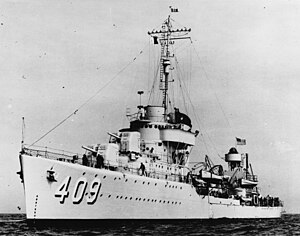Sims-class destroyer

USS Sims, lead ship of the class, on trials in 1939. The Mk 37 director has not yet been installed.
|
|
| Class overview | |
|---|---|
| Name: | Sims class |
| Builders: | |
| Operators: |
|
| Preceded by: | Benham class |
| Succeeded by: | Benson class |
| Built: | 1937–40 |
| In commission: | 1939–46 |
| Completed: | 12 |
| Lost: | 5 |
| Retired: | 7 |
| General characteristics | |
| Type: | Destroyer |
| Displacement: |
|
| Length: | 348 ft 3 in (106.15 m) |
| Beam: | 36 ft 1 in (11.00 m) |
| Draft: | 13 ft 4 in (4.06 m) |
| Installed power: |
|
| Propulsion: | 2 shafts |
| Speed: | 37 knots (69 km/h; 43 mph) on trials |
| Range: | 5,640 nmi (10,450 km; 6,490 mi) at 12 knots (22 km/h; 14 mph) |
| Complement: |
|
| Armament: |
|
| Notes: | fuel capacity: 444 tons (2,929 barrels) |
The Sims class of 12 destroyers was built for the United States Navy, and commissioned in 1939 and 1940. They were the last United States destroyer class completed prior to the American entry into World War II. All Sims-class ships saw action in World War II, and seven survived the war. No ship of this class saw service after 1946. They were built under the Second London Naval Treaty, in which the tonnage limit on destroyer standard displacement was lifted, but an overall tonnage limit remained. Thus, to maximize the number of destroyers and avoid developing an all-new design, the Sims class were only 70 tons larger as designed than previous destroyers. They are usually grouped with the 1500-ton classes and were the sixth destroyer class since production resumed with the Farragut class in 1932.
The class served extensively in World War II, and five of the class were lost in the war. Of the five ships lost, four were at the hands of the Japanese and one at the hands of the Germans. The class served on Neutrality Patrols in the Atlantic in 1940-41. Except for Roe, Wainwright, and Buck, the class was transferred to the Pacific shortly after the attack on Pearl Harbor. All of the ships saw extensive combat service. At the war's end in August 1945, three of the seven survivors were undergoing overhauls that were left unfinished, and were ultimately scrapped. The remaining four seaworthy ships were used as targets during the 1946 Operation Crossroads atomic tests at Bikini Atoll. One was sunk by the first blast, while the other three were sunk as targets two years later after serving as experimental platforms.
Compared with the Benhams, the Sims class were increased 8 feet (2.4 m) in hull length, and started a trend of increased size that led to the numerous larger 2100-ton destroyer classes that marked wartime construction. The class was designed by Gibbs & Cox. They incorporated streamlining of the bridge structure and the forward part of the hull, in an attempt to increase speed and improve fuel economy. They also had an additional 5-inch gun, with the torpedo tubes re-arranged so one less quadruple mount could be used while maintaining an eight-tube broadside.
...
Wikipedia
